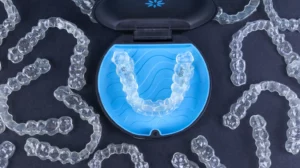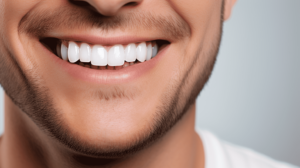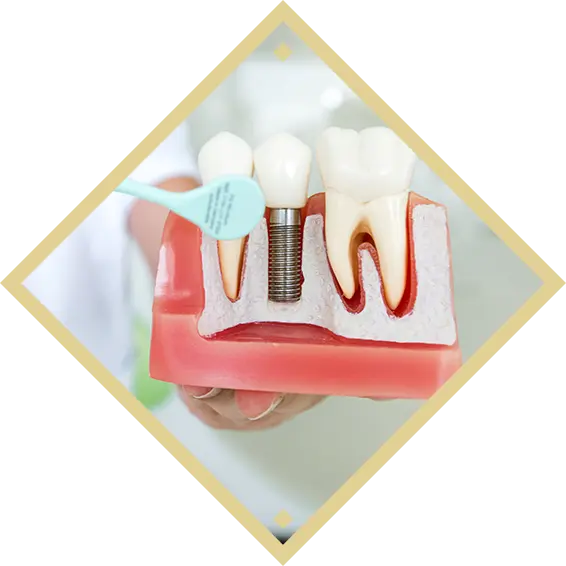It’s a question that often pops up for those considering orthodontic treatment or currently undergoing it. The simple answer is: they can be, but not always. They can cause discomfort, but they’re typically manageable and temporary. And the level of pain experienced varies from person to person and often diminishes as your mouth adjusts to the aligners. Some individuals experience minimal discomfort, others may find it more challenging to adapt. Here we are going to delve deeper into the topic to understand the nuances of aligner discomfort and how to manage it effectively.
What are Clear Aligners?
Aligners are a type of orthodontic treatment that utilizes a series of clear, custom-made trays to gradually shift teeth into their desired position. Unlike traditional braces, which use brackets and wires to move teeth, they are virtually invisible and removable, offering a discreet and convenient way to straighten teeth. Each set of aligners is worn for a specified period, typically around one to two weeks, before being replaced with the next set in the series. As the patient progresses through the aligner trays, their teeth gradually move into alignment, guided by the precise design of each tray.
They are commonly used to correct a range of orthodontic issues, including crowding, spacing, overbite, underbite, and crossbite. They offer several advantages over traditional braces, including improved aesthetics, minimal interference with daily activities such as eating and brushing, and reduced discomfort.
Overall, aligners offer a discreet, convenient, and effective way to achieve a straighter smile, making them a popular choice for individuals seeking orthodontic treatment.
Understanding Aligners and Discomfort
The level of discomfort caused by aligners can differ depending on various factors, such as individual pain tolerance, the severity of misalignment, and the specific stage of treatment. Initially, when wearing a new set of aligners, it’s common to experience some soreness as your teeth adjust to the pressure exerted by the aligners. This discomfort is often likened to a dull ache or pressure sensation and typically subsides within a few days as your mouth adjusts.
Pain in Your Tooth
Occasionally, you might experience discomfort localized to a particular tooth or teeth. This can happen when a specific tooth is being moved into its correct position. As the aligners apply pressure to shift teeth, it’s natural for some teeth to experience more movement and, consequently, more discomfort than others. However, this discomfort is usually temporary and diminishes as the tooth adjusts to its new position.
Jaw Ache from Aligners
In addition to tooth soreness, some individuals may experience jaw ache or tension, particularly during the first few days of wearing a new set of aligners. This discomfort can result from the adjustment of your bite and the repositioning of your jaw to accommodate the aligners. Similar to tooth soreness, jaw ache tends to lessen over time as your mouth adapts to the aligners.
What Causes Aligners to “Hurt”?
The discomfort associated with aligners primarily stems from the pressure exerted on your teeth to facilitate movement. This pressure is necessary for orthodontic treatment to be effective, as it gradually shifts your teeth into the desired alignment. While the pressure itself isn’t inherently painful, it can cause soreness and discomfort as your teeth and surrounding tissues adjust.
What Should Be Done If Your Aligners Clench?
Aligners may fit too tightly, leading to clenching or discomfort beyond the usual adjustment period. If you experience persistent discomfort or find that your aligners are causing excessive pressure or irritation, it’s crucial to consult your orthodontist. They can assess your situation and make the necessary adjustments to ensure your treatment progresses comfortably and effectively.
How Do You Handle Discomfort from Aligners?
Fortunately, there are several strategies you can employ to alleviate discomfort and make wearing aligners more manageable:
Over-the-counter pain relievers:
Non-prescription pain medication such as ibuprofen or acetaminophen can help reduce the soreness and discomfort associated with aligner treatment.
Orthodontic wax:
Applying orthodontic wax to areas of your aligners that cause irritation can help alleviate discomfort by creating a barrier between the aligner and your gums or soft tissues.
Warm salt water rinses:
Rinsing your mouth with warm salt water can help soothe sore gums and alleviate discomfort caused by aligners.
Eating softer foods:
Opting for softer foods during the initial adjustment period can reduce the strain on your teeth and gums, making wearing aligners more comfortable.
Using chewies:
Chewies are small cylindrical cushions that help seat aligners properly and can also aid in reducing discomfort by distributing pressure more evenly across your teeth.
Maintaining good oral hygiene:
Keeping your teeth and aligners clean can help prevent irritation and discomfort caused by food particles or bacteria trapped between your aligners and teeth.
Conclusion
At Dr. Joseph’s Dental Clinic, we’re committed to providing personalized orthodontic care tailored to your unique needs. Our professional doctor is here to support you every step of the way, from the initial consultation to the completion of your treatment journey.
If you’re considering aligner treatment or experiencing discomfort during your orthodontic journey, don’t hesitate to reach out to us. We’re here to address any concerns you may have and ensure your treatment progresses comfortably and effectively.
Take the first step towards a healthier, straighter smile today. Schedule your consultation with Dr. Joseph’s Dental Clinic, and let us help you achieve the smile of your dreams.










